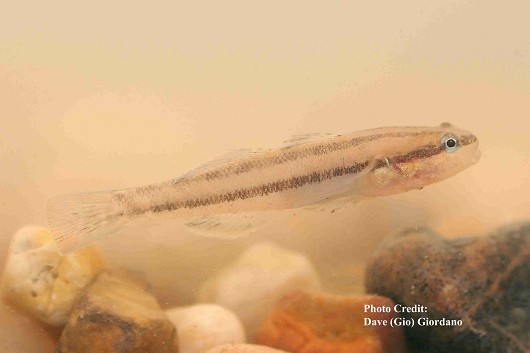Shimofuri Goby
-
Scientific NameTridentiger bifasciatus
-
NativeNo
-
Identification
 Shimofuri goby, approximately 5 cm (2”) long. Location: Suisun Marsh, California Date: 8/6/2007.
Shimofuri goby, approximately 5 cm (2”) long. Location: Suisun Marsh, California Date: 8/6/2007.- Stout body with blunt, flattened head, and a thick caudal peduncle
- Small eyes close to the top of the head
- Rounded tail
- Maxillae extend to nearly the back of the eye
- 54-60 scales along the lateral line
- Pores on top of the head, between the eyes
- 2 distinct dorsal fins, the first with 6-7 spines and the second with 1 spine and 11-14 rays
- Anal fin has 1 spine and 9-12 fin rays
- Large, round, transparent pectoral fins with 19-23 rays and a white band at the base
- Pelvic fins unite to form a sucker disc
- Variable coloration but most have tiny white speckles fringed with orange on the head, the ventral surface, edge of the second dorsal fin, and the anal fin
- Tiny spots cover the tail in rows
- A stripe runs from the base of the head to the base of the tail on the top of each side
- A dark band runs along the midline of each side
-
Life History
The Shimofuri Goby has become widely distributed in the San Francisco estuary but is most common in shallow water areas with complex arrangements of rocks, tule root masses, logs, and other debris providing cover and mating territories. Shimofuri Gobies are resilient and have been found in shallow ponds at low tide where temperatures vary widely, and reach up to 34°C. Shimofuri Gobies can also be found in salinities up to 19 ppt, although lab data show distress at 17 ppt, and they can breed in both fresh and brackish water. Adults are mostly sedentary, intensely defending a small area they have selected for breeding. Shimofuri Gobies feed by biting into the substrate and pulling out hydroids and tube dwelling amphipods, or by ripping the tentacles from feeding barnacles.
Spawning occurs March through August in temperatures ranging from 13°C to 34°C and salinities from 0 ppt to 7 ppt. A male will protect a cavity under a rock ,shell, or artificial cavity like a pipe to which the female can attach her eggs. The male will then fertilize the eggs and protect them, feeding mostly on dead embryos until he dies of exhaustion. Both sexes mate multiple times throughout the season resulting in an almost constant stream of pelagic larvae rising through the water column before being dispersed by tidal currents. Most only live for 12-18 months, until they are mature enough to breed, but some may live for a full 2 years. Most will grow to 35-60 mm TL in a year and 105 mm TL is the largest recorded.
This information is based on the San Francisco Estuary population but there is also a population based in Pyramid Reservoir, Nevada, and the rivers downstream of it. It is likely that these freshwater populations have a somewhat different life history.
-
Links to Other ResearchN / A
